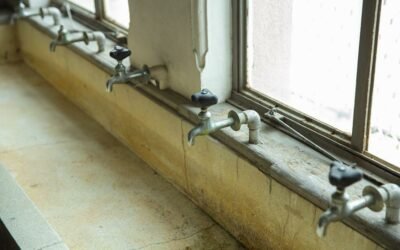Do you know if home inspectors check for mold?
It's crucial to understand the role of home inspectors in mold detection and why it's important during a home inspection.
In this article, we will explore what to expect during a home inspection for mold and the common signs that home inspectors look for.
Additionally, we will discuss the necessary steps to address any mold found during a home inspection.
Stay informed and proactive in maintaining a healthy home environment.
Key Takeaways
- Home inspectors play a crucial role in detecting and addressing mold issues within residential properties.
- Mold detection during a home inspection is important for the safety and well-being of occupants and the structural integrity of the property.
- Home inspectors thoroughly assess the property for signs of mold growth, including conducting visual examinations and using specialized equipment.
- If mold is found during a home inspection, steps should be taken to identify and fix the source of moisture and remove the mold, potentially with the help of a professional mold remediation company.
The Role of Home Inspectors in Mold Detection
Home inspectors play a crucial role in detecting and addressing mold issues within residential properties. When it comes to mold detection, their expertise and thorough inspections are invaluable. They have the knowledge and experience to identify potential areas where mold may be present and can take the necessary steps to address the issue.
During a home inspection, a professional inspector will thoroughly examine the property, including areas that are prone to moisture buildup, such as bathrooms, kitchens, and basements. They will look for visible signs of mold, such as discoloration or staining on walls, ceilings, or floors. Additionally, they may use specialized tools like moisture meters to detect hidden moisture that could lead to mold growth.
Home inspectors also understand the importance of proper ventilation and will assess the property's ventilation systems to ensure that they are functioning effectively. Inadequate ventilation can contribute to excess moisture, creating an ideal environment for mold to thrive.
If mold is detected during an inspection, the home inspector will provide recommendations on how to address the issue. This may include suggesting further testing or referring the homeowner to a qualified mold remediation specialist.
Why Mold Detection Is Important in a Home Inspection
When conducting a home inspection, it is crucial to prioritize mold detection. Mold can pose serious health risks and cause significant damage to a property if left undetected and untreated. Here are three reasons why mold detection is important in a home inspection:
| Reason | Explanation |
|---|---|
| Health Risks | Mold can release spores into the air, which can be inhaled and cause respiratory problems, allergies, and even infections. Identifying and addressing mold issues during a home inspection helps ensure the safety and well-being of the occupants. |
| Structural Damage | Mold can thrive in moist environments and can gradually weaken the structural integrity of a property. By detecting and addressing mold growth early on, home inspectors can prevent further damage to the building's structure, saving homeowners from costly repairs down the line. |
| Property Value | Mold infestations can significantly reduce the value of a property. By detecting and addressing mold issues during a home inspection, potential buyers can make informed decisions and negotiate repairs or price adjustments, protecting their investment.
What to Expect During a Home Inspection for Mold
During your home inspection for mold, the inspector will thoroughly assess the property for any signs of mold growth. This process typically begins with a visual examination of areas that are prone to mold, such as bathrooms, kitchens, basements, and crawl spaces. The inspector will look for visible signs of mold, such as discoloration or staining on walls, ceilings, or floors. They'll also inspect areas with high humidity or water damage, as these conditions often lead to mold growth.
In addition to the visual inspection, the inspector may use specialized equipment to detect mold that isn't visible to the naked eye. This can include moisture meters, which measure the moisture content in materials, and thermal imaging cameras, which can detect temperature differences that may indicate hidden moisture or mold.
Furthermore, the inspector may collect samples of suspected mold for laboratory testing. These samples can help identify the type of mold present and determine if it poses a health risk. The inspector may also take air samples to measure the concentration of mold spores in the indoor environment.
Once the inspection is complete, the inspector will provide a detailed report that outlines their findings, including any areas of mold growth, the extent of the problem, and recommendations for remediation. It's important to note that a home inspection for mold isn't a remediation service, but rather an assessment of the property's current condition.
Common Signs of Mold Home Inspectors Look for
One of the first signs home inspectors look for when checking for mold is the presence of a musty odor. Mold has a distinct smell that's often described as damp, earthy, or like wet socks. This odor is a telltale sign that there may be mold growth hidden somewhere in the home.
In addition to the musty odor, home inspectors also look for other common signs of mold, including:
- Visible mold growth: Inspectors will carefully examine walls, ceilings, floors, and other surfaces for any visible signs of mold. Mold can appear in various colors, including black, green, brown, or white.
- Water stains: Stains on walls or ceilings can indicate a past or ongoing moisture problem, which can create the perfect conditions for mold growth.
- Condensation: Excessive condensation on windows, pipes, or other surfaces can be a sign of high humidity levels, which can promote mold growth.
- Peeling or bubbling paint: Mold can cause paint to peel, bubble, or become discolored. Inspectors will look for these signs, especially in areas with high moisture, such as bathrooms or basements.
- Allergic reactions: If residents of the home experience allergic symptoms such as sneezing, coughing, or itchy eyes, it could be a sign of mold presence.
Steps to Address Mold Found During a Home Inspection
To address mold found during a home inspection, you will need to take immediate action. Mold can have serious health implications and can also lead to structural damage if left untreated. Here are the steps you should follow to address the mold issue:
| Step | Action |
|---|---|
| 1 | Identify the source of moisture and fix it to prevent further mold growth. |
| 2 | Wear protective gear, including gloves, goggles, and a respirator, when dealing with mold. |
| 3 | Remove any visible mold by scrubbing the affected area with a bleach solution or a specialized mold cleaner. Make sure to dry the area thoroughly afterwards. |
| 4 | If the mold is extensive or located in hard-to-reach areas, consider hiring a professional mold remediation company. They have the expertise and equipment to handle the situation safely and effectively. |
| 5 | Once the mold is removed, it's crucial to address the underlying moisture issue. This may involve fixing leaks, improving ventilation, or installing dehumidifiers. |
| 6 | Monitor the area regularly for any signs of mold recurrence and take immediate action if necessary. |
Conclusion
In conclusion, home inspectors play a crucial role in detecting mold during a home inspection.
Mold detection is important because it can pose health risks and cause damage to the property.
During a home inspection, inspectors carefully look for common signs of mold and take the necessary steps to address any mold found.
Their thorough and detail-oriented approach ensures that potential mold issues are identified and addressed, providing homeowners with peace of mind and a healthy living environment.






0 Comments